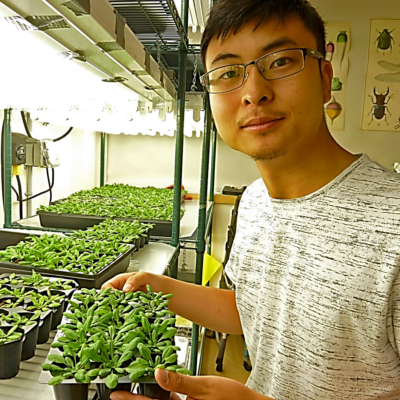Newsroom
UBC researchers find how plants can actively recruit beneficial microbes to help protect them against future pathogen attack
The Haney Lab in the UBC Department of Microbiology and Immunology published research in Nature Plants that shows how plants can benefit the future of microbiology research and agriculture.
If you sense a pathogen, can you recruit beneficial bacteria to help protect against those pathogens? It turns out, plants can.
The Haney Lab, a research lab in the UBC Department of Microbiology and Immunology, has published a paper in Nature Plants with trainee support from the Michael Smith Laboratories called “FERONIA restricts Pseudomonas in the rhizosphere microbiome via regulation of reactive oxygen species.”
Upon sensing pathogens (organisms which cause disease), plants can actively recruit beneficial microbes, called their microbiome, to help protect them against future pathogen attack. This induces a phenomenon called disease suppressive soils, whereby the microbiome protects plants from disease. This new research from first author Dr. Yi Song and other members of the Haney lab, with contributions from scientists at Duke University, is the first clear example of how recruiting beneficial microbes in plants is actually done. Understanding how beneficial microbes are recruited has the potential to be used in agriculture to sustainably protect plants from pathogens.
Improving the future of sustainable agriculture
The lab’s findings show the discovery of a single pathway that senses pathogens and reshapes the microbiome into one that’s protective.
FERONIA, named after the Roman goddess of fertility, is a plant receptor that affects many aspects of plant development including fertility and growth. “Normally, plants produce and sense peptides that regulate FERONIA activity to fine tune growth and immunity,” shares Dr. Cara Haney. It turns out that pathogens can make those same peptides to try to hijack plant immunity. Dr. Song found that plants, in turn, are monitoring the pathway and recruiting good bacteria.
Since fungal pathogens are the leading cause of crop loss in agriculture, and consequentially, large amounts of fungicides are necessary to control them; suppressive soils have been well described in wheat and other grains, but nobody knew how it worked. Dr. Song shares that this work has revealed that plants can “cry for help” to beneficial bacteria to protect them against pathogens. The lab’s findings show the discovery of a single pathway that senses pathogens and reshapes the microbiome into one that’s protective. The idea is that by manipulating this pathway, plants can recruit beneficial microbes that would reduce the necessary input of fungicides, which helps prevent disease and damage to plants. This has the potential to reduce cost, increase sustainability, and make plants more resistant to pests and pathogens.
Plant immune systems as a model for research
Because innate immunity share similarity in plants and animals, understanding how plants can recruit beneficial microbes could help researchers understand how this process works in the human gut as well. For instance, beneficial bacteria in the human gut have also been associated with protection from bacterial and viral pathogens, so it is of broad interest whether and how animals recruit beneficial microbes in the gut.
“Plants are a much more tractable system,” says Dr. Haney. “We can make genetic and mechanistic advances very quickly and affordably compared to mice, which are more cost and labour intensive. We hope that this work will inform how animals, including humans, recruit beneficial microbes when we sense a pathogen. When it comes to the interface of immunity, the microbiome, and pathogens, we hope plants can be a model for many organisms.”
Read more about this research in Nature Plants: https://www.nature.com/articles/s41477-021-00914-0
Find out more about more about the Haney Lab: https://haneylab.msl.ubc.ca
This story was originally published by the Department of Microbiology and Immunology

